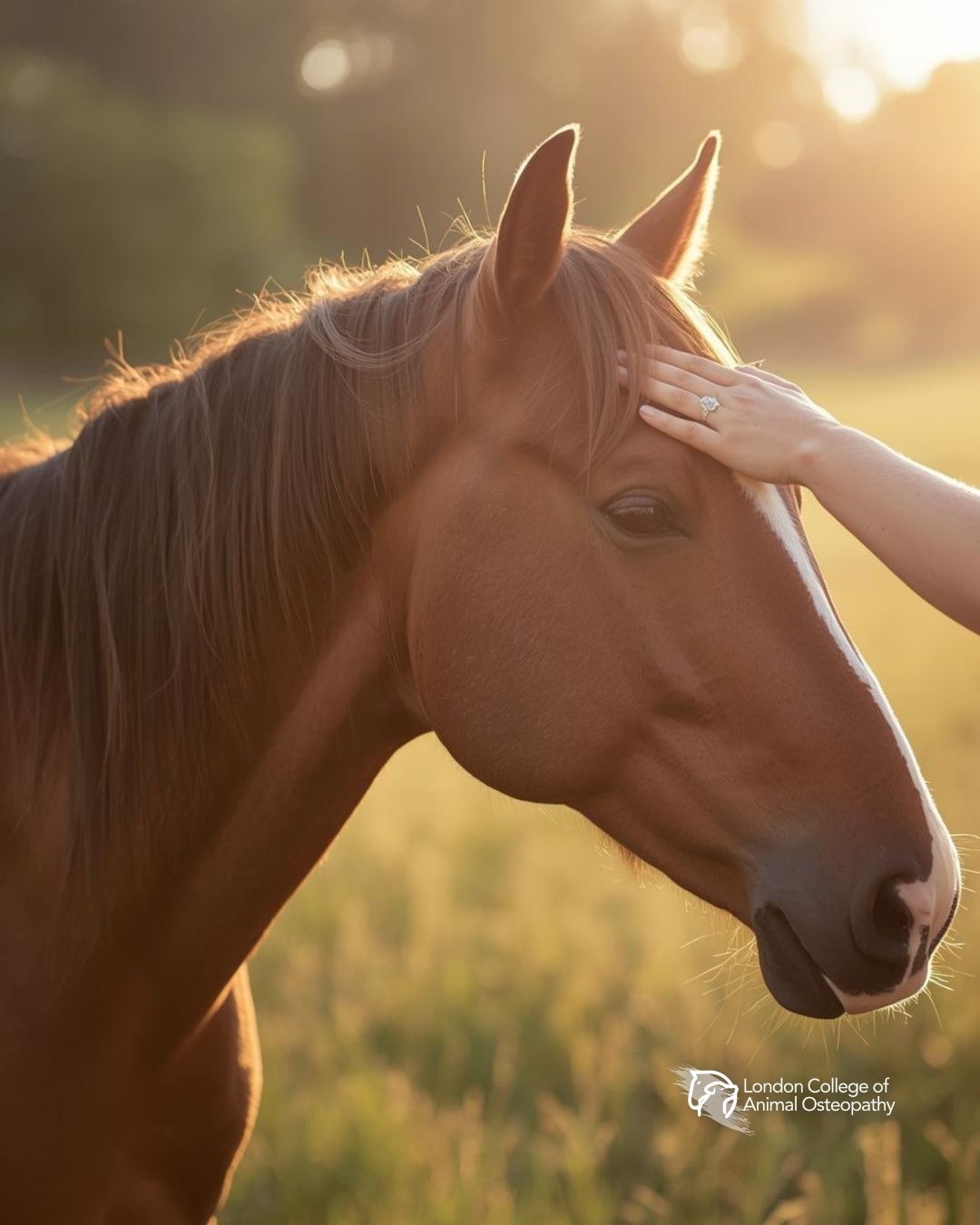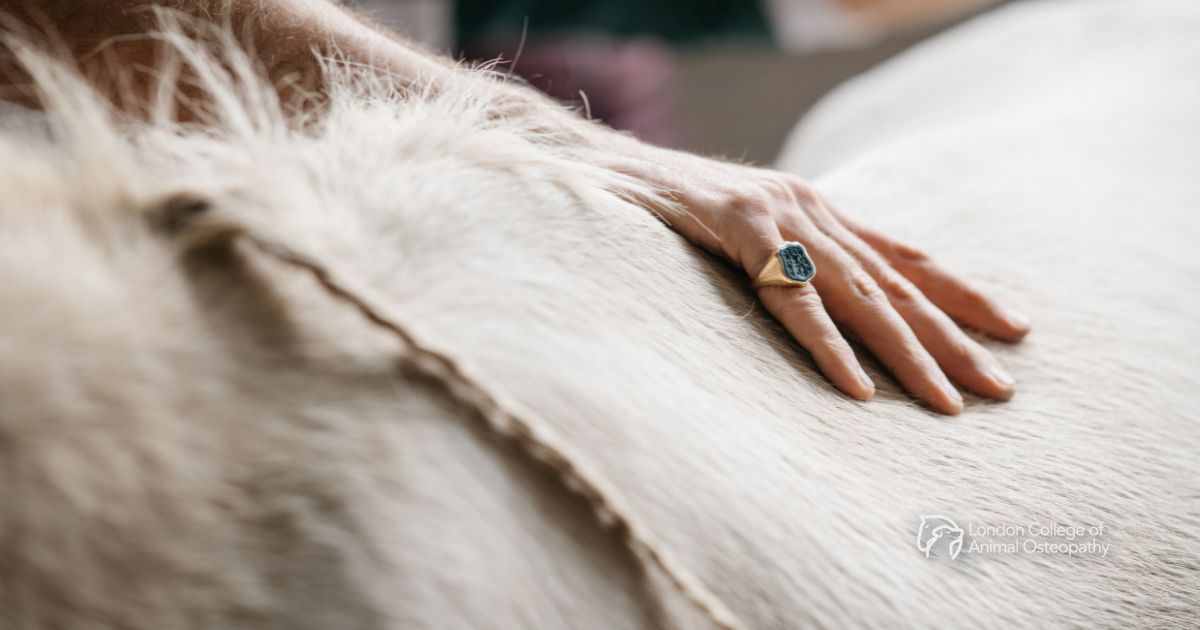Energy Work and Animal Patients: Beyond the Physical
By Chris Bates M.Ost, DipAO, EEBW, BHSAI
In the animal therapeutic industry, energy workers, Reiki healers and other more esoteric practitioners have been present for a very long time. Considering the history of energy work, it could be argued that they were there first. Due to the nature of these disciplines, there is some scepticism from both owners and other practitioners as to the validity and the effectiveness. On the other side of the coin, there are ardent supporters and regular users of these therapies who swear by the effects and sometimes have the treatment for themselves too.
In Osteopathy, we embrace approaches that suit the individual and have positive clinical effects, so it's not surprising to know that there are some Animal Osteopaths who also use energy work in practice. This article aims to investigate the area of energy work and where it fits in the wider therapy industry.
The Ancient Origins of Energy Healing

There are a variety of practices that date back to ancient times from various locations across the world but all who share similarities in their theories and approach. The cultivation of proper energy flow throughout the body is seen within civilisations across the world and the methods of doing so often look similar.
Prana and the Indian Tradition
In the ancient civilisations of India, techniques of bodily discipline and breathing were taught as a way of guiding the life force or "Prana" throughout the "Nadis" which were channels for this energy. Gestures called mudras were used to direct and control these energy flows for both physical benefit and for spiritual progression. Much of these techniques can be seen in some Yoga classes today but often a watered down version of that which was written in texts such as the Hatha Yoga Pridipika and Vedic scriptures.
Also coming from ancient Indian origins and linked with these physical techniques was the practice of ayurvedic medicine. This approach is closely linked with Yoga philosophy too. Ayurvedic practitioners/physicians work with the whole life cycle from pre-natal and birth to geriatric care. The ayurvedic theory of the three Doshas is a fundamental concept; these elemental qualities of being can be out of balance and certain remedies, activities or even spiritual pursuits can help to balance these out.
Reiki: Japanese Universal Life Force Energy
Reiki is a prominent practice internationally with its history in Japan. Dr Mikao Usui developed Reiki in the early 1900's after he went on a 21 day meditation retreat in the mountains. Reiki literally translates as "universal life force energy" and is a process of the practitioner channeling this energy via themselves into a person, animal or even events and distant healing. There is a focus on symbols that the practitioner uses to enhance healing or attune others to the energies so they may use them as well. These symbols were revealed to Dr Usui during his spiritual awakening and form a unique aspect to this discipline.
Ritual, Crystals and Vibrational Healing
Some approaches to energy work include the use of crystals and other objects that may have ritual significance. Sound and vibration healing are sometimes incorporated into other healing work and more research is being conducted into certain frequencies and their potential healing properties.
Ritual can be a defining aspect of some healing practices and while there may be similarities between the theories, cultural and historical influences are seen in the ritualistic aspects. Crystals for example, are often placed in specific grids or locations over and around the body that correspond with certain intentions or desired effects.
In Reiki and some other practices the locations of hand positions are governed (to an extent) by the "Chakras" which are energy centers of vortexes corresponding with various biological and spiritual functions. Chakra means "wheel" in Sanskrit and there are 7 main ones along the spine with some traditions describing many other smaller ones throughout the body. These ritual ideas are often based on either trial and error over millennia of practice that is then described in the words and philosophy of the culture; or influenced by religious and spiritual texts.
How Does Energy Healing Work? The Science Behind the Practice
The basis of many energy therapies is one of a universal energy or spiritual interaction that cannot be measured directly by any instruments we currently have. This of course leaves space for great scepticism among the scientific community and unfortunately practitioners will find professional "push back" from some in the industry and the veterinary profession.
However, the real life impacts and results that people report are undeniable. Whether the most effective component is placebo or not, doesn't really matter to patients. It would be very difficult to write off energy work on animals having a placebo effect however intelligent we like to think our furry friends are.
Evidence for Reiki in Animal Studies
There is good evidence suggesting the calming effects of Reiki in animals and practitioners often discuss the interaction with reiki and increased parasympathetic tone. That "rest and digest" mode of the parasympathetic nervous system is demonstrated in papers such as Baldwin, Wagers and Schwartz (2008) where Reiki was shown to significantly reduce heart rate of rats exposed to noise stress.
Baldwin and Schwartz also found that microvascular leakage and damage due to noise induced stress was reduced with the application of Reiki in their earlier 2006 paper. The benefits of resistance to stress are obvious in either human or animal models and so if Reiki is boosting the resilience of the patient then this could have a dramatically beneficial role in wider veterinary care. Complementary therapies for chronic pain

Shiatsu: Finger Pressure and Meridian Therapy
Shiatsu is a therapy of Japanese origin that translates as "Finger pressure". The practitioners use pressure to stimulate the flow of energy or "Ki" throughout the body. This Ki moves via channels known as meridians. The Ki is synonymous with the universal energy spoken about in other traditions and nourishes the physical body but also acts as the energy body's equivalent of nerve, blood and lymph (with which we work as Osteopaths).
Some who seek a more scientific explanation have hypothesised that the meridians run congruently with major neural distributions and effect the same dermatomes and myotomes (cutaneous and muscular innervation). This could explain some of the positive effects on the physical body such as reduced pain sensitivity and muscle tension; there could even be a neural explanation for the more systemic objectives of meridian stimulation via somatovisceral pathways.
Some schools of Shiatsu also use the 5 element theory and this sits in a similar vein to the Indian Ayurvedic approach. The characteristics of elemental forces can be balanced by treatment, some of these characteristics can be attributed to the physical. Without the modern understanding of physiology and by a process of trial and error, it could be that these elemental forces were simply a way of explaining the symptoms that were present such as lethargy, fever or inflammation.
Where Osteopathy Meets Energy Work: A Holistic Integration
Osteopaths aim to offer information to the body to allow it to function optimally and maintain healthy homeostasis. We adjust the environment both external and internal which supports the mechanisms and materials of the body functions to reach balanced health. A discipline like Shiatsu would seem very similar in that it aims to remove blockages to the routes of energy flow. Osteopathy aims to alleviate the restrictions to blood supply, nerve conduction and lymphatic movement. It may even be that some of the Shiatsu interventions also impact these physical vessels too.
Universal Energy as Vital Input
The provision of healing methods that channel universal energy (Chi, Ki, Prana or any other description) would fit very well with Osteopathic principles too. Osteopaths see the animal patient as a whole entity and consider the inputs that being receives as part of their assessment. If we consider the beneficial effects that are clearly observed as shown in the research cited earlier, we can note this as adding to the animal's general vitality and measure the outcomes while we use Osteopathic interventions to promote the same vital reserve.
Although the scope of the Osteopath, one of the growing holistic veterinary therapies, generally does not include in-depth nutrition plans (unless they are otherwise qualified), advice on balanced and beneficial feeding is certainly part of the service. This could be considered the application of an input in the same way that universal energy is. Perhaps the patient needs a balanced and appropriate diet for their constitution and activities the same way they need appropriate energy inputs via channelling.
Conclusion: Multiple Paths to Animal Health and Wellbeing
The goal of any therapist is to help the patient achieve health and wellbeing. Health and wellbeing look different for every patient and so the way to get there will look different too. The various professions and disciplines that treat animals and humans are simply looking at the route to health from different angles. There are many paths to the top of the metaphorical mountain. Integrative approach to animal welfare
To disregard any one path or point of view based on a lack of understanding is simply ignorant and it is pleasing to say that many Osteopaths are very open to collaboration with energy workers and may even be trained themselves. Osteopathy as a profession is a very open minded and forward thinking community. The evidence for energy work speaks for itself and it could be argued that healing is just as much evidence based medicine (EBM) as the more conventional material approaches.
Learn about the LCAO International Diploma in Animal Osteopathy program
FAQs
- Does energy healing like Reiki actually work on animals?
Yes, scientific research demonstrates measurable benefits. Studies published in the Journal of Alternative and Complementary Medicine show that Reiki significantly reduces stress responses in animals, including decreased heart rate and reduced cellular damage from stress. Since animals cannot experience placebo effects, these documented physiological changes provide compelling evidence for energy work's therapeutic benefits.
- Can osteopaths use energy work alongside manual therapy for animals?
Yes, many animal osteopaths integrate energy work into their practice as both disciplines share similar holistic philosophies. Energy modalities like Shiatsu work with meridians in ways that complement osteopathic principles of supporting blood flow, nerve function, and lymphatic drainage. This integrated approach can be particularly beneficial for anxious or stressed animals.
- What is the difference between Reiki and Shiatsu for animals?
Reiki involves channeling universal life energy through light touch or hands held near the body, with no physical pressure applied. Shiatsu uses finger pressure on specific points along meridians (energy channels) to stimulate energy flow, similar to acupressure. Both promote relaxation and support healing, but Shiatsu is more physically hands-on whilst Reiki is primarily energetic.
References
Baldwin, A.L. and Schwartz, G.E. (2006). Personal interaction with a Reiki practitioner decreases noise-induced microvascular damage in an animal model. Journal of Alternative and Complementary Medicine (New York, N.Y.), [online] 12(1), pp.15–22. doi:https://doi.org/10.1089/acm.2006.12.15.
Baldwin, A.L., Wagers, C. and Schwartz, G.E. (2008). Reiki improves heart rate homeostasis in laboratory rats. Journal of Alternative and Complementary Medicine (New York, N.Y.), [online] 14(4), pp.417–422. doi:https://doi.org/10.1089/acm.2007.0753.
Cardim, J.M., Braga, B.P., Santos, D.M., Quaresma, E.C., Thais, I., Da, S.V., Franklim, L., Junior, Dos, R., Dos, R., Rodrigues, D., Richer Praxedes Maia, Salgado, D. and Auzier, H. (2023). The Benefits of Shiatsu for a Holistic Approach to Health: A Systematic Review. Journal of advances in medicine and medical research, 35(23), pp.238–257. doi:https://doi.org/10.9734/jammr/2023/v35i235298.
Longhurst, J.C. (2010). Defining Meridians: A Modern Basis of Understanding. Journal of Acupuncture and Meridian Studies, [online] 3(2), pp.67–74. doi:https://doi.org/10.1016/s2005-2901(10)60014-3.
AHVMA (American Holistic Veterinary Medical Association)


.jpg)
.png)
.png)